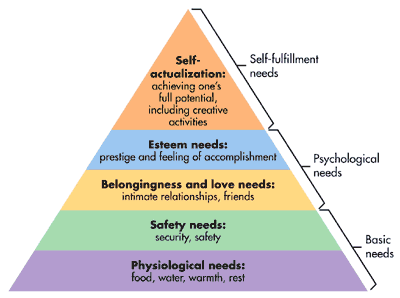Understanding Abraham Maslow's Hierarchy of Needs
Thought processes and the cognitions of the human brain had always been a passion of Abraham Maslow's, and this is evident when you look at the contribution he made to the development of modern psychology. The hierarchy of needs he created, and in 1943, released, is still used as a model to illustrate human motivation in classrooms across the US - and much further afield. How then, can we explain the concept? And what parts of ordinary life do each of the stages relate to?
Before setting out to produce his famous hierarchy of needs - normally represented in pyramid form - Maslow looked to determine what it is humans seek in life. After much theorizing, he concluded that we search for things that will fulfill our needs for survival, as well as our emotional happiness and self-satisfaction.

With the need for survival at the base of the pyramid, it is understood that this is the most important need of all. Physiological needs, as they are known, are items that we must have to stay alive - namely food and water of some description. Although all of the needs depicted on the model are important to both our physical and mental well-being, our basic physiological requirements are always prioritized. Without them, we would die; without needs further up the pyramid, we may well still survive - just not as happily as we could do.
Next in Maslow's model are our safety needs: the things we need in life to feel protected against external influences - from both man and nature. This level includes having a paid, stable job; owning an insured property; being able to access health care; and living in a neighborhood that is relatively safe, secure and comfortable.
At the midway point of the hierarchy of needs, the requirements start to become less urgent than previously, but still significant to our overall health and happiness. Social needs relate to feeling appreciated by others for who we are and how we act. Love is a key element to happiness, and to fulfill our social requirements entirely, we must feel this emotion to some extent.
The penultimate layer of the hierarchy describes the importance of self-esteem, which depends upon the light in which we perceive ourselves: positive or negative. Even if this is our own personal view, it is often influenced by how we are viewed by others in society. Do we feel fully recognized for what we have done and achieved? If so, it's likely that we are meeting our esteem needs - meaning we could well be on our way to total satisfaction in life.
In order to reach self-actualization (the final stage described above), we must feel as though we have reached our potential and achieved something worthy of recognition in our lives. At this point, we will be able to see through what others say; we will be content with ourselves and our own lives, so other people's opinions have become far less important and soul-destroying.
Not everyone ascends to this level, sadly, but those who do are rewarded with a better sense of self-awareness and understanding. By tackling each of the five layers in Maslow's hierarchy, you're well on your way to a life of happiness!